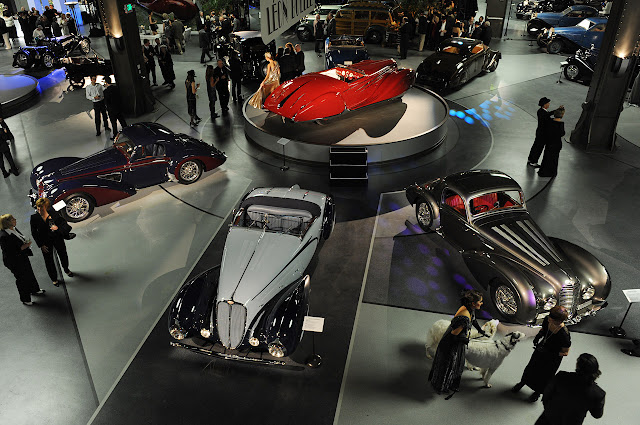
Oxnard, Calif. (2010) – The Mullin Automotive Museum, a facility that will pay homage to the art deco and machine age design eras (1918-1941) that produced exquisite art and magnificent automobiles, will officially open its doors for the first time in the beach community of Oxnard, Calif., Spring 2010.
The dramatic facility will be a three-dimensional celebration of the pre-World War II Belgian/French decorative arts movement, long described as Art Deco. Sharing the more than 50-thousand square-feet of exhibit space will be one of the finest collections of coach-built automobiles, furniture and art from the Deco era.
A display of more than 100 historic French cars is planned to include examples from Delahaye, Delage, Talbot-Lago, Voisin, Hispano-Suiza and of course, Bugatti, wrapped in voluptuous forms from the iconic coachbuilding ateliers of Chapron, Figoni et Falaschi, Gangloff, Vanvooren, Labourdette, Letourneur et Marchand and Saoutchik, among others. And, while his work was exclusive to the cars created by his father, Jean Bugatti was among the best designers of his time and will also be well represented, along with the art of his sister, uncle, father and grandfather.
Next to the Pebble Beach Concours winning automobile restorations will be displayed 30 automotive treasures in as-found condition before a 90-foot diorama of the barn in which they were discovered. These cars are the core of the Schlumpf ―Reserve Collection.‖ It includes many cars, purchased by the Schlumpf brothers in the early 60s from American sportsman John Shakespeare. This remarkable juxtaposition will also illustrate the work required to make a barn-find car into an award-winning showpiece. The Schlumpfs were industrialists of the Alsace region of France. Their goal was to bring all the Bugattis back to where they had been created. What became an enormous collection is now called “Musée National – Collection Schlumpf” in Mulhouse, France. It includes dozens of Bugattis among many other important French classics.
On the nearly 11-thousand square foot mezzanine is planned another exhibit of French classics from the less sensual Grand Prix and Le Mans sports-racing school of design including Gabriel Voisin’s incredible ―Laboratoire‖ experimental racer. They will be shown in a pre-WWII Le Mans track and racing pit diorama to give viewers a sense of the casual atmosphere once enjoyed by the racing elite.
“Club Bugatti” will share the second floor. Here we will be encouraged by Mr. Mullin to remember that the Bugatti name and its creative gene predated and paralleled the famous Ettore, so reverently chronicled in the automotive world. The family art exhibit will include priceless furniture created by Ettore’s father Carlo near the beginning of the last century, bronze sculptures by Ettore’s brother Rembrandt and elegant pastels and charcoal drawings by Ettore’s daughter, Lidia. The entrance to the Club will be around a freestanding wall containing a set of Carlo Bugatti’s splendid doors.
The science of the Twenty-first Century will protect the art of the Twentieth. A well-integrated green power supply and supporting insulation will create an interior climate carefully tuned for preservation. In that atmosphere, the priceless restorations and fine art pieces will cease measurable age.
An elevator will rise from the main floor through the mezzanine to a roof deck and garden. Art deco waveform grilles surround the elevator mechanism. The elevator tower includes a staircase and will double as a photo gallery illustrating Parisian life during the ―Belle Époque.‖ The rooftop view will include the green discipline of the 21st century facility. The roof itself is sealed in thermoplastic polyolefin (TPO) with heat-welded seams. The surface is so white and smooth, its manufacturer states it will reflect 20% of the solar heat away from the interior. An array of photovoltaic panels collects the area’s nearly uninterrupted daytime access to solar power and a set of ducted-turbine generators makes use of the steady ocean breeze. Their design will actually advance the deco theme above the museum’s entrance. Below them, the entrance is shaded by an Eiffelesque iron portico supporting dozens of tinted windshields that looks both period correct and apropos collections within.
Mr. Mullin would like the collection to be known as a museum of the art deco period. The mature forms of that new design language were established by ―l’Exposition International des Arts Décoratifs et Industriels Modernes‖ (1925); dubbed Art Moderne for many years then Art Deco by a journalist in 1960. That concise description has survived half a century. In spite of the best efforts of a devoted connoisseur of Arts Décoratifs Modernes, it will likely be the Arts Industriels that will raise emotions and make memories – it will be the cars.
Swiss sculptor Max Bill described the convergence of fine and industrial art of the period; ―Whether he like it or not, those who create new forms succumb to the influence of modern art…Comparison between an automobile and the sculpture of its time will show how close the relationship is between works of art and the forms of useful objects.‖ Contemporary designer Philippe Charbonneaux describing Figoni’s work said, “…very much an artist…a master of curves and elegant lines.” Even the connoisseurs in Britain could not resist colorful commentary. As auto enthusiast and noted aficionado Sir Peter Ustionov suggested: “One drives, of course, an Alfa Romeo; one is driven in a Rolls Royce; but one gives only a Delage to one’s favorite mistress.” Sir William Lyons, father of the sweeping forms of SS and Jaguar cars, described the classic French work as, “positively indecent.”
[Source: Mullin Automotive Museum]




















